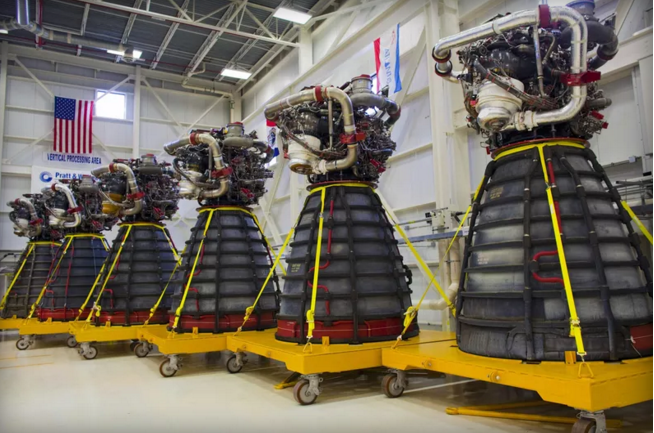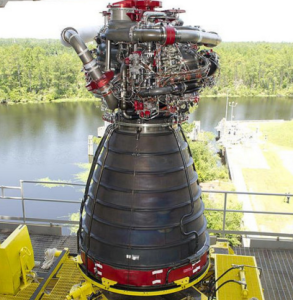Aerojet Rocketdyne has a long history with NASA. The aerospace and defense company has been supplying the agency with engines and rocket launchers since the early days of space travel; Aerojet’s RS-25 engine has the proud distinction of having been used to power all 135 Space Shuttle flights since its first mission in 1981. The RS-25, also known as the Space Shuttle Main Engine, may soon acquire a new title: the Space Launch System Engine. NASA’s new mission, which ultimately should bring humans to Mars, is well underway, and they’ve just awarded Aerojet Rocketdyne a $1.6 billion contract to continue to supply them with a steady stream of RS-25 launchers for the next decade.
The Space Launch System (SLS) is the next step up from the Space Shuttle, and it’s been given an impressive list of missions for the next two decades. It will take humans deeper into space than they’ve ever been before, with an ultimate goal of bringing a crew to the surface of Mars sometime in the 2030s. An Orion crew capsule is expected to be launched into lunar orbit in 2020. Needless to say, the SLS is going to need a lot of engines, and so the reliable RS-25 was the obvious choice.
 Modifications would need to be made, however. The SLS will experience colder temperatures, higher speeds and greater pressures than the Space Shuttle, so Aerojet is making some changes to the RS-25. Modifications have already been made to the 16 engines in NASA’s possession. The engines’ power has been upgraded from 491,000 pounds to 512,000 pounds of vacuum thrust, hugely boosting the amount of weight that can be lifted into the atmosphere. The new, sleeker engines, which Aerojet will be building for future SLS missions, will be more affordable and will require fewer parts and welds than the older ones, thanks in part to state-of-the-art manufacturing technologies including five-axis milling machines, digital X-rays… and, of course, 3D printing.
Modifications would need to be made, however. The SLS will experience colder temperatures, higher speeds and greater pressures than the Space Shuttle, so Aerojet is making some changes to the RS-25. Modifications have already been made to the 16 engines in NASA’s possession. The engines’ power has been upgraded from 491,000 pounds to 512,000 pounds of vacuum thrust, hugely boosting the amount of weight that can be lifted into the atmosphere. The new, sleeker engines, which Aerojet will be building for future SLS missions, will be more affordable and will require fewer parts and welds than the older ones, thanks in part to state-of-the-art manufacturing technologies including five-axis milling machines, digital X-rays… and, of course, 3D printing.
 NASA has been testing a number of 3D printed engine components lately with the help of Aerojet Rocketdyne, and the RS-25 engines were hot-fired this past May. The 16 upgraded engines, which are currently being stored at NASA’s Stennis Space Center, will be used for the first four SLS missions, including the first two critical test flights known as Exploration Mission-1 and Exploration Mission-2. The agency is going to need a lot more than 16 engines in the future, however; unlike the Space Shuttle, the SLS rocket launchers will not be recovered after each launch, so a new engine will need to be built each time. That’s great news for Aerojet Rocketdyne, which is now under contract with NASA until 2024. The $1.6 billion contract will give the company plenty of money to supply new and improved engines for the next decade.
NASA has been testing a number of 3D printed engine components lately with the help of Aerojet Rocketdyne, and the RS-25 engines were hot-fired this past May. The 16 upgraded engines, which are currently being stored at NASA’s Stennis Space Center, will be used for the first four SLS missions, including the first two critical test flights known as Exploration Mission-1 and Exploration Mission-2. The agency is going to need a lot more than 16 engines in the future, however; unlike the Space Shuttle, the SLS rocket launchers will not be recovered after each launch, so a new engine will need to be built each time. That’s great news for Aerojet Rocketdyne, which is now under contract with NASA until 2024. The $1.6 billion contract will give the company plenty of money to supply new and improved engines for the next decade.
There’s still a long road ahead. The first SLS has not yet been built, and its first test flight is not scheduled until 2018. NASA has not yet made any official bulk orders for the RS-25 engines, but the contract includes one order, and the plans for the SLS indicate that there will be many more in the future. It’ll be a while before we can finally see, firsthand, if there is life on Mars, but we’re closer now than we’ve ever been before.
Subscribe to Our Email Newsletter
Stay up-to-date on all the latest news from the 3D printing industry and receive information and offers from third party vendors.
You May Also Like
3D Printing Unpeeled: Wind Turbines, Probiotics and Lenses
TPI Composites, ORNL and Ingersoll Rand are working to make wind turbine tooling segments that can be 18.3 meters long. These elements also include resistive wires that help keep the...
3D Printing Unpeeled: Digital FDM Filament for Functional Gradients
Just published in Nature, a paper by a Seoul National University team looks at “3D printing with a 3D printed digital material filament for programming functional gradients.” Sang-Joon Ahn, Howon...
3D Printing Unpeeled: $5000 Cold Spray 3D Printer, Roland DGA & Living Materials
The AeroForge is a $5000 cold spray metal printer for copper made by a student team at Rice University. In a paper for ACS Central Science a team from Nanjing...
3D Printing Webinar and Event Roundup: April 28, 2024
In this week’s 3D Printing Webinar and Event Roundup, the Ceramics Expo is taking place in Michigan, Stratasys continues its advanced training courses, and SPE is holding a Polymer Characterization...

































